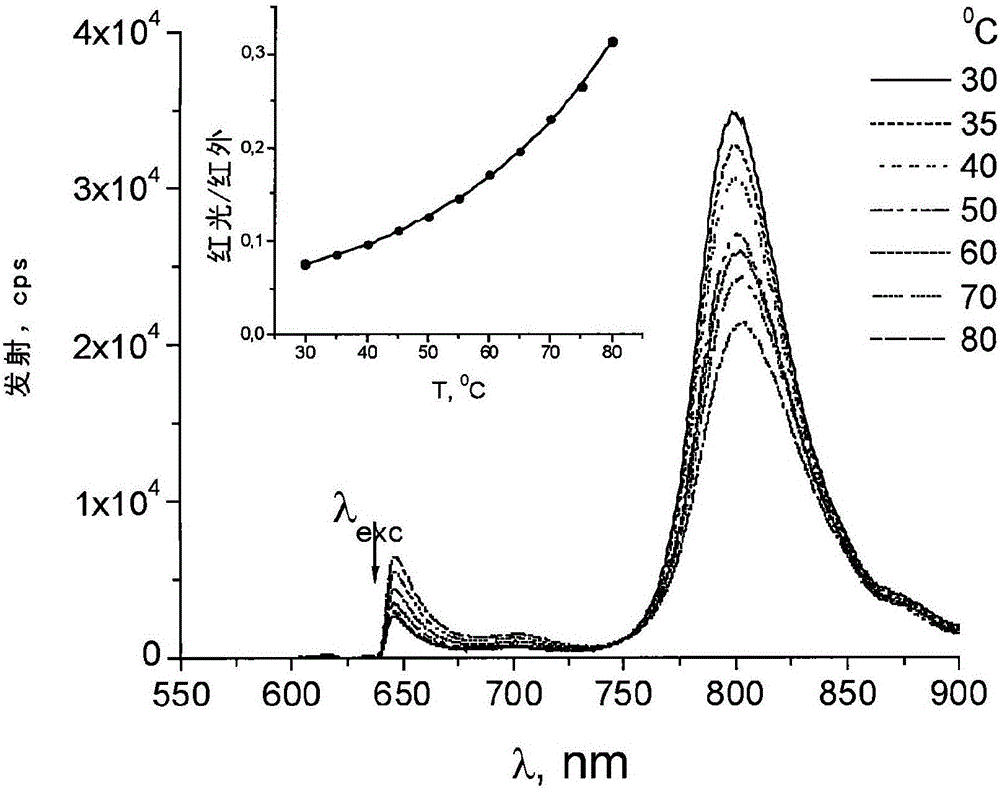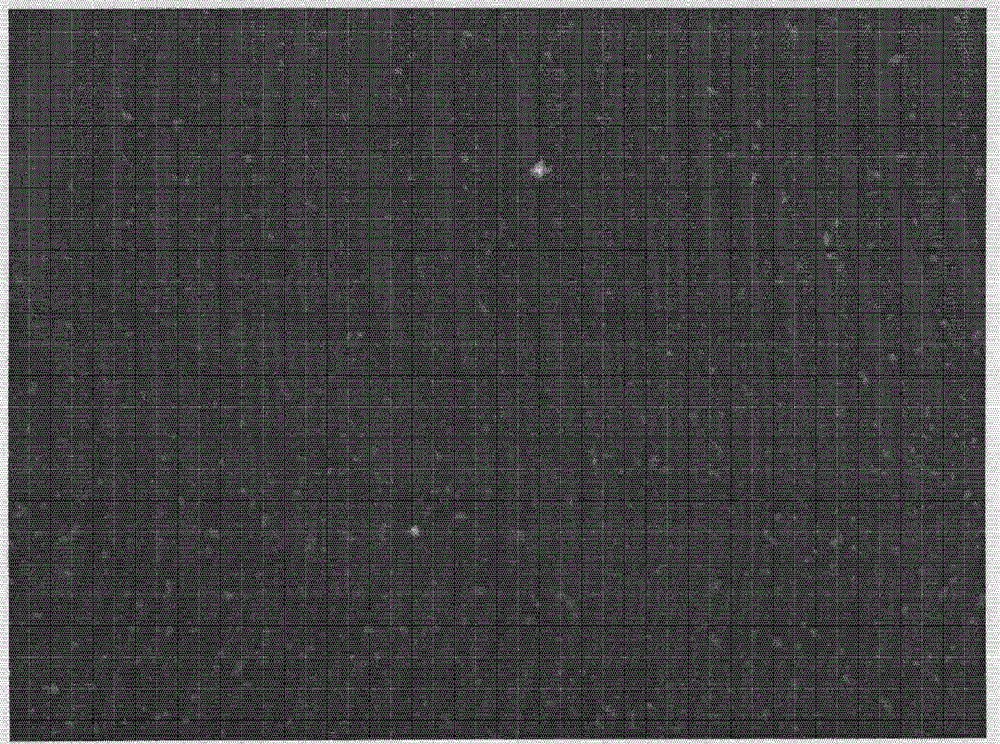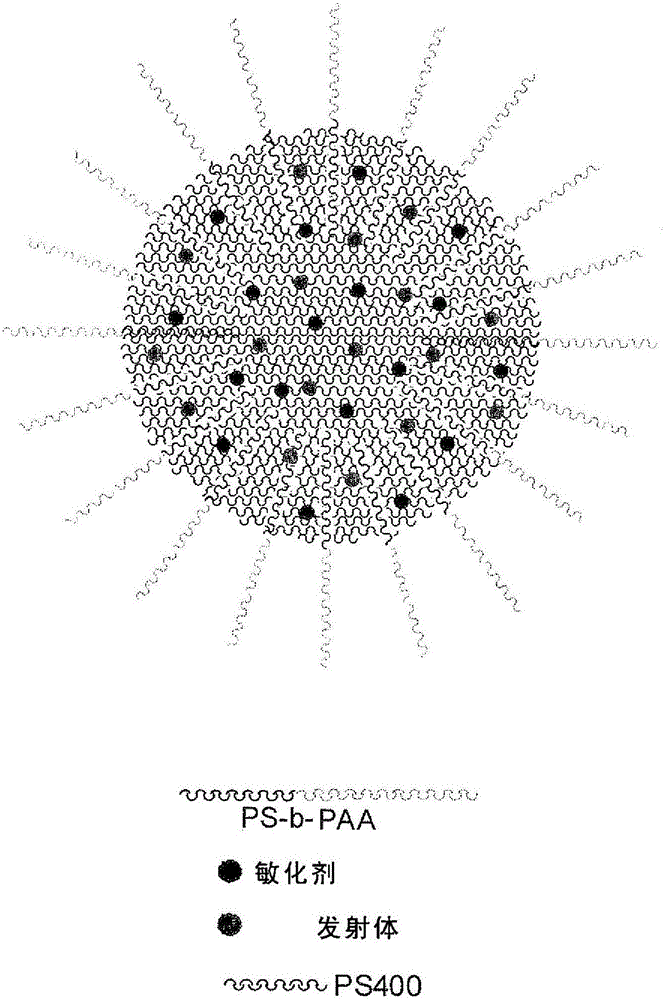Organic polymeric photon up-conversion nanoparticles for biological applications
A nanoparticle, polymeric technology, applied in the field of oxygen and other substances that will affect the upconversion process, pressure, temperature perception, and organic photon upconversion nanoparticles, can solve the problems that cannot affect the ratio of wavelengths, low efficiency, etc.
- Summary
- Abstract
- Description
- Claims
- Application Information
AI Technical Summary
Problems solved by technology
Method used
Image
Examples
Embodiment approach
[0114] Sensitizer molecule (or "sensitizer component")
[0115] A "sensitizer" is a molecule capable of absorbing light, and the sensitizer is an organic dye or a metal-organic complex, preferably triplet-rich.
[0116] A metal-organic complex is defined as a compound comprising at least a metal M surrounded by one or more molecules, so-called ligands L, usually bound to the metal ion by coordinate-covalent bonds.
[0117] Ligands are cyclic or acyclic, aromatic or nonaromatic, monodentate or polydentate organic molecules.
[0118] In cases where the ligand is an amplified aromatic system, the ligand itself is the organic dye sensitizer without being bound to the metal.
[0119] For a better understanding, both Pd-porphyrins (=metal-organic complexes) and metal-free porphyrins (=organic molecules) are sensitizers.
[0120]
[0121] Metal organic complexes can be:
[0122] -Has the general formula ML m single core,
[0123] Wherein m is the number of ligands, m=1-8, p...
Embodiment 1
[0321] Embodiment 1: Preparation of nanoparticles
[0322] An amphiphilic block copolymer as a stabilizer, a polymer as a polymeric organic matrix component, and at least two organic dyes (5×10 -5 Sensitizer for M, 5 x 10 -4 M) was dissolved in THF (tetrahydrofuran), and the resulting solution (volume: 10 ml) was stirred for 2 hours. Then, pour 40ml of MilliQ water all at once (within 1 s) to add 40ml of the above water. Other possible methods of mixing with the aqueous phase have been outlined above. The solution was stirred overnight (or up to 48 hours), then filtered under vacuum through No. 1 Whatman filter paper. Thereafter, first THF and then water were removed using a vacuum rotary evaporator, and the residue was dried in vacuo for another 2 hours. Subsequently, 40 ml of MilliQ water were added and the solution was stirred overnight, then dewatered and dried as described above. Finally, the residue was dissolved in 10 ml MilliQ water (resulting in a homogeneous n...
Embodiment 2
[0372] Example 2: Upconverting Emission from Nanoparticles
[0373] Nanoparticles (NP) according to the present invention were dispersed in water and excited with different intensities of 633 nm light. Figure 3A , 4A and 5 respectively represent the emission spectrum of the nanoparticles (=nanoparticle 1 of = embodiment 1) that adopts perylene as the emitter, and the emission spectrum of the nanoparticles (=nanoparticle 3 of = embodiment 1) that adopts BPEA as the emitter; And the emission spectrum of the nanoparticles (=nanoparticle 2 of Example 1) using PhP as emitter. In all three cases, the spectra indicated even 2 High-efficiency upconversion (peak at ~480nm, = blue light) is still present at excitation intensities of
PUM
| Property | Measurement | Unit |
|---|---|---|
| Thickness | aaaaa | aaaaa |
Abstract
Description
Claims
Application Information
 Login to View More
Login to View More - R&D
- Intellectual Property
- Life Sciences
- Materials
- Tech Scout
- Unparalleled Data Quality
- Higher Quality Content
- 60% Fewer Hallucinations
Browse by: Latest US Patents, China's latest patents, Technical Efficacy Thesaurus, Application Domain, Technology Topic, Popular Technical Reports.
© 2025 PatSnap. All rights reserved.Legal|Privacy policy|Modern Slavery Act Transparency Statement|Sitemap|About US| Contact US: help@patsnap.com



